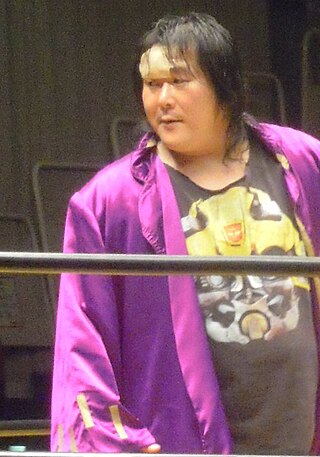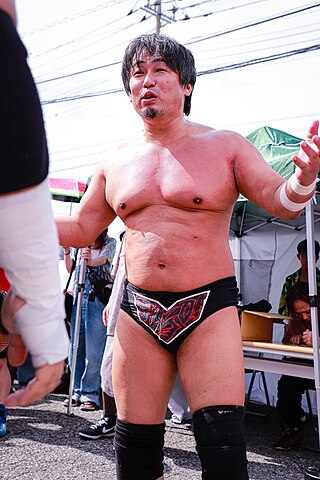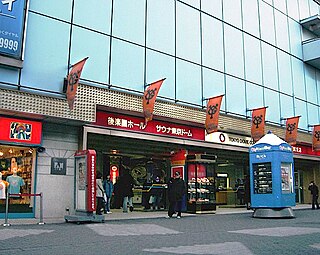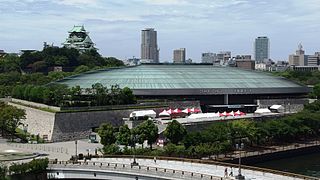
Eiji Ezaki was a Japanese professional wrestler, stage actor, musician and professional wrestling promoter, better known under the ring name Hayabusa. He was best known for his time with Frontier Martial-Arts Wrestling (FMW), where he primarily wrestled throughout his career and was the franchise player of the company between 1995 and 2001.

Frontier Martial-Arts Wrestling-Explosion (FMW-E) is a Japanese professional wrestling promotion founded on July 28, 1989, by Atsushi Onita as Frontier Martial-Arts Wrestling (FMW). The promotion specializes in hardcore wrestling involving weapons such as barbed wire and fire. They held their first show on October 6, 1989. In the late 1990s, FMW had a brief working agreement with Extreme Championship Wrestling, and as well had 14 DVDs released in the U.S. by Tokyopop. On March 4, 2015, FMW was resurrected under the name Chō Sentō Puroresu FMW. With the resurrected FMW not holding any events since 2018, Onita announced in 2021 that he would be starting Frontier Martial-Arts Wrestling-Explosion (FMW-E) in which the promotion would specialize in exploding death matches.

Masanori Morimura better known under his ring name Ricky Fuji is a Japanese professional wrestler currently signed to Action Advance Pro Wrestling, where he also runs the day-to-day operations. He is perhaps best known for his time with Frontier Martial-Arts Wrestling (FMW), where he wrestled between the promotion's early days in 1990 until the promotion's closure in 2002, making him the longest-tenured wrestler in the company's history.
The FMW Independent Heavyweight Championship was a professional wrestling world heavyweight championship contested in Frontier Martial-Arts Wrestling (FMW). It was one of the top two titles in the company, along with the FMW Brass Knuckles Heavyweight Championship. The title belt was created for Atsushi Onita to use in his retirement match at 6th Anniversary Show in 1995 but could not be shipped to FMW at that time and the title was finally shipped to FMW in 1996 and FMW used it as the alternative top title to the Brass Knuckles Heavyweight Championship. Both titles were unified later that year and were collectively referred to as "FMW Double Championship". The titles were separated in 1999 and deactivated later that year in favor of the new WEW Single Championship.

Yukihiro Kanemura, better known by his ring name Kintaro Kanemura, is a Zainichi Korean retired professional wrestler. He also wrestled under the ring name Wing Kanemura. He is best known for his death matches in Apache Army, Big Japan Pro Wrestling (BJW), Extreme Championship Wrestling (ECW), Frontier Martial-Arts Wrestling (FMW), International Wrestling Association (IWA) and Wrestling International New Generations (W*ING).

Masashi Honda is a Japanese retired professional wrestler. He is best known for his work in Frontier Martial-Arts Wrestling (FMW) under the ring name Mr. Gannosuke.
Koji Nakagawa is a Japanese semi-retired professional wrestler best known for his work in Frontier Martial-Arts Wrestling (FMW) between 1992 and 2002. He is perhaps best known for his “Hitman” character, heavily inspired by Canadian professional wrestler Bret Hart. Nakagawa also wrestled as Goemon between 2000 and 2002, a dark thief character that was eventually killed and turned into a ghost in storyline.
Welcome to the Darkside was a professional wrestling pay-per-view (PPV) event produced by Frontier Martial-Arts Wrestling (FMW). The event took place on August 22, 1998 at the DirecTV Studio in Tokyo, Japan.
FMW 9th Anniversary Show: Entertainment Wrestling Live was the first professional wrestling pay-per-view (PPV) event produced by Frontier Martial-Arts Wrestling (FMW). The event took place on April 30, 1998, at the Yokohama Cultural Gymnasium in Yokohama, Japan. This was the first FMW event to be broadcast on pay-per-view via DirecTV. The event commemorated the ninth anniversary of FMW and was the first to be broadcast on pay-per-view.

Tetsuhiro Kuroda is a Japanese professional wrestler, currently competing as a freelancer on the Japanese independent circuit. He is best known for his time with Frontier Martial-Arts Wrestling (FMW), where he primarily competed from 1993 until the promotion's closure in 2002.

The FMW 5th Anniversary Show was a professional wrestling event produced by Frontier Martial-Arts Wrestling (FMW). The event took place on May 5, 1994 at the Kawasaki Stadium in Kawasaki, Kanagawa, Japan. This was the fifth edition of the company's flagship event Anniversary Show, commemorating the fifth anniversary of the company. It was the third edition of the event to take place at Kawasaki Stadium and took place on May 5 for the second consecutive year. May 5 would become a significant date for FMW like January 4 was for New Japan Pro-Wrestling (NJPW).

FMW 6th Anniversary Show was a professional wrestling event produced by Frontier Martial-Arts Wrestling (FMW), taking place on May 5, 1995 at the Kawasaki Stadium in Kawasaki, Kanagawa, Japan. This was the sixth edition of the company's flagship event Anniversary Show, commemorating the sixth anniversary of the company and the third consecutive and fourth overall edition of Anniversary Show at Kawasaki Stadium.

ZEN was a professional wrestling stable in Frontier Martial-Arts Wrestling (FMW). The group was led by former FMW owner and the company's founder Atsushi Onita from late 1997 to mid 1998 and the group was based on World Championship Wrestling's New World Order (nWo). The group produced its own shows in collaboration with FMW like nWo promoted its own pay-per-view nWo Souled Out.
Team No Respect was a professional wrestling faction in Frontier Martial-Arts Wrestling (FMW), which existed in the company between 1998 and 2000. The ideology of the group was that they disrespected all the wrestlers in FMW as well as the company's management and President Shoichi Arai. TNR was formed after Mr. Gannosuke, Yukihiro Kanemura and Hido turned on their ZEN leader Atsushi Onita out of jealousy with Onita due to his high ego and selfishness and formed a major alliance with Fuyuki-Gun. TNR was the most popular, successful and influential stable in the history of FMW and were involved in FMW's major storylines and rivalries during its two and a half year existence.
Super Extreme Wrestling War was a series of professional wrestling events produced by Frontier Martial-Arts Wrestling (FMW) in 1997. These events marked the first time that FMW began a partnership with American counterpart Extreme Championship Wrestling (ECW) and a working relationship began between the two companies as ECW wrestlers competed at these events and it marked the beginning of interpromotional matches and events between ECW and FMW. These events would create a huge impact in FMW's storylines as they concluded with the breakup of ZEN when Mr. Gannosuke, Yukihiro Kanemura and Hido attacked their leader Atsushi Onita out of jealousy after Hayabusa pinned Onita in a WarGames match. They merged with Fuyuki-Gun to form Team No Respect, which would dominate FMW until 2000.

Goodbye Hayabusa was the name of two professional wrestling series of events produced by Frontier Martial-Arts Wrestling (FMW) in 1999. The backstory of the series was that on-screen FMW Commissioner Kodo Fuyuki decided to end Eiji Ezaki's "Hayabusa" character after August 25, 1999 and the tour consisted of farewell matches of Ezaki's Hayabusa character and the end of it. The first part of the event took place between July 18 and July 31, 1999 and the second part of the event took place between August 20 and August 25, 1999. The series also introduced the WEW 6-Man Tag Team Championship, a substitute for the FMW World Street Fight 6-Man Tag Team Championship, which had been retired and awarded to the departing Atsushi Onita by FMW President Shoichi Arai on November 20, 1998 for establishing FMW and taking it to a huge level.

Goodbye Hayabusa II: Haunted House was a professional wrestling live event produced by Frontier Martial-Arts Wrestling (FMW) as part of the Goodbye Hayabusa tour on August 20, 1999 at the Korakuen Hall in Tokyo, Japan. The tour would feature the end of the Hayabusa character in FMW.
Goodbye Hayabusa II: Last Match was a professional wrestling pay-per-view (PPV) event produced by Frontier Martial-Arts Wrestling (FMW). The event took place on August 25, 1999, at the Nakajima Sports Center in Sapporo, Japan. The pay-per-view was the last event in the Goodbye Hayabusa tour used to retire Eiji Ezaki's "Hayabusa" character and to showcase the character's final matches. The tour was used as a build-up to Hayabusa's new character "H", which was tested during Darkside Hayabusa's revival at Haunted House and Ezaki would debut his H character on August 27.

Summer Spectacular (1994) was the third Summer Spectacular professional wrestling event produced by Frontier Martial-Arts Wrestling (FMW). The event took place on August 28, 1994 at the Osaka-jō Hall in Osaka, Japan.










